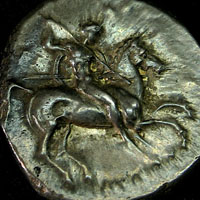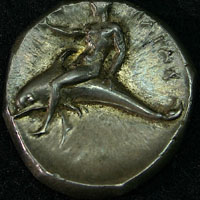

Silver Didrachm, 281-276 BCE
weight: 7.9g, width: 2.05cm
OBV.: Nude warrior on horseback galloping right, carrying round shield and two spare spears in left hand, another spear pointed downwards in right. Remnants of inscriptions left behind rider (SI) and between horse’s legs (LYKWN) (= Lykon, probably the mint master).
REV.: Young heros riding dolphin left; inscription TARAS right.
HFMA nr. 2006.010.012. Ref.: Vlasto 695, SNG ANS 1069, HN Italy 967.
The famous 'horsemen' first appear on Tarentine coins around 450 BCE. Heroically nude on the earliest and many later coins, they probably refer to equestrian games at Tarentum, or they may simply be a representation of the aristocratic spirit of the Tarentines. The military poses of some of these horsemen have also been interpreted as allusions to Tarentum's constant struggles with its neighbors, especially the non-Greek Lucanians and Messapians.
The dolphin rider on the reverse probably represents the mythical Spartan founder, Phalantos. The story went that Phalantos suffered shipwreck near the Tarentine coast and was safely brought to shore by a dolphin. The inscription Taras reflects the city's Greek name, but also the name of a nearby river and the god living in it. Accordingly, the dolphin rider has also been interpreted as the god Taras. Yet in classical Greek art, river deities are usually depicted as half-man, half-bull.
This particular coin originates from the dramatic final phase of the city's independence (1), as evidenced by the unabbreviated signature of the official supervising the minting process, Lykon, and the relatively high weight of this specimen (2). In 282 BCE, a small Roman flotilla on a mission to aid the Greek city of Thurioi north of Tarentum had dared to sail into Tarentum's harbor in violation of an earlier treaty that barred Roman ships from entering the Gulf of Tarentum. The Tarentines responded to this provocation by sinking or capturing half of the ships. Then they went to Thurioi and expelled the Roman garrison there. In the next year, a Roman envoy sent to negotiate was publicly humiliated in the city's theater. Tarentum engaged a famous general, king Pyrrhus of Epirus, for assistance in the ensuing war against the Romans. Pyrrhus defeated the Romans twice, but the second victory, at Asculum in 279 BCE, came at such great cost that he famously remarked, "If we win one more victory against the Romans, we will be completely ruined" (4). Subsequently, Pyrrhus abandoned Southern Italy in favor of Sicily. In the end, Rome won the Pyrrhic War (280-272 BCE) and forced Tarentum to accept a permanent Roman garrison on its acropolis.
O.K.
(1) Evan's Period VI, which Fischer-Bossert puts at 281-276 BCE.
(2) The weight of Tarentine didrachms would soon be reduced from around 8.2g to around 6.6g.
(3) Dionysius of Halicarnassus, Antiquitates Romanae 19.5.
(4) Plutarch, Life of Pyrrhus 21.14.
Literature:
Brauer, Jr., G. C., Taras: its History and Coinage. New Rochelle, NY: Caratzas, 1986.
Evans, A. J., "The 'Horsemen' of Tarentum," Numismatic Chronicle n.s. 3, 9 (1881), 1-242.
(2) The weight of Tarentine didrachms would soon be reduced from around 8.2g to around 6.6g.
(3) Dionysius of Halicarnassus, Antiquitates Romanae 19.5.
(4) Plutarch, Life of Pyrrhus 21.14.
Literature:
Brauer, Jr., G. C., Taras: its History and Coinage. New Rochelle, NY: Caratzas, 1986.
Evans, A. J., "The 'Horsemen' of Tarentum," Numismatic Chronicle n.s. 3, 9 (1881), 1-242.
Fischer-Bossert, W. Chronologie der Didrachmenprägung von Tarent, 510-280 v. Chr. Berlin: DeGruyter, 1999.
Ravel, Oscar E., Descriptive Catalogue of the Collection of Tarentine Coins formed by M. P. Vlasto. Chicago: Obol International, 1977.
Ravel, Oscar E., Descriptive Catalogue of the Collection of Tarentine Coins formed by M. P. Vlasto. Chicago: Obol International, 1977.

